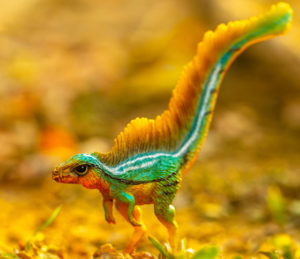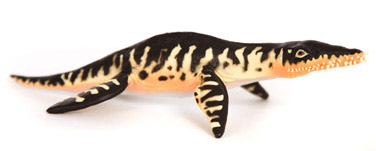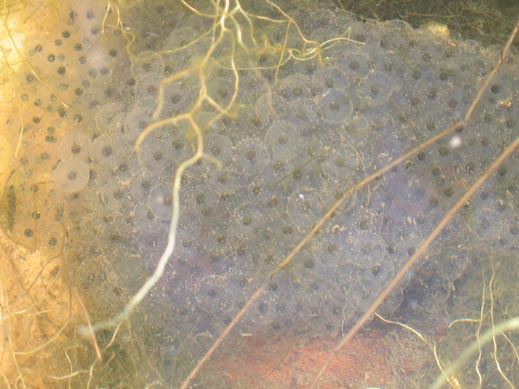New Chinese Feathered Dinosaur adds to Confusion over Evolution of Feathers
A paper published in the scientific journal “Nature” is ruffling a few feathers amongst palaeontologists as the authors postulate that bird-hipped dinosaurs had feathers too! A team from the Shandong Tianyu Museum of Nature in China have reported on the discovery of a partial skeleton of a small, potentially bipedal dinosaur with feathers. The fossil was found in the early Cretaceous sediments of the Liaoning Formation in north-eastern China.
The Evolution of Feathers
Feathered dinosaurs from Liaoning have been found before, the region is world famous for the remarkable fossils of feathered dinosaurs and birds that have been discovered. These creatures drowned in a lake, sinking to the bottom and in most cases they were rapidly buried by fine volcanic ash without much disruption to their remains. Several kinds of feathered saurischian dinosaurs are known from the Cretaceous sediments of this region, animals such as Sinosauropteryx and Sinornithosaurus for example. However, there are a number of surprising features about this new discovery that have “ruffled a few feathers” according to an Everything Dinosaur spokesperson or alternatively, “has muddied the waters” in a similar comment made by a leading palaeontologist.
Firstly, although only part of this small dinosaur’s body has been fossilised, the Chinese team were able to identify limb bones, vertebrae, the hip girdle and most importantly the lower jaw and most of the lower and mid portions of the skull. The animal has been identified as a member of the Heterodontosauridae, a very primitive ornithischian dinosaur, best known form Early Jurassic deposits from South Africa.
Heterodontosaurid Fossils
The heterodontosaurids are believed to be a basal group of the ornithischian dinosaurs and this is the first time that a fossil of such an animal has been found in China. This specimen has been dated to the Early Cretaceous approximately 140 million years ago (Berriasian faunal stage). This new fossil indicates that these dinosaurs, the heterodontosaurids, survived into the Cretaceous. The heterodontosaurs are distinguished by their complex teeth. The name Heterodontosauridae means”different-toothed lizards”, these little dinosaurs had remarkably advanced dentition. Instead of the simple peg-like teeth seen in other herbivorous dinosaurs of the Early Jurassic this group had sharp, pointed, over sized canines and those teeth towards the back of the jaw were flatter and broad, designed for crushing plant matter. It is thought that these dinosaurs may have been omnivores. A general, non-specialised diet may be one reason why these little dog-sized dinosaurs persisted so long in the Mesozoic.
This information alone, would be enough to excite most scientists but for the Chinese specimen the fossil reveals an even more intriguing attribute – feathers.
Tianyulong confuciusi
The analysis of the dinosaur named Tianyulong confuciusi by the Chinese scientists has revealed the presence of primitive protofeathers along the back and front of the animal (dorsal and ventral areas). Finding a new feathered dinosaur in Liaoning is not that remarkable given the fantastically rich fossil pedigree of the place, but a feathered ornithischian, that is a different matter.
The fossil found, represents a sub-adult, it was approximately 1 metre long with a long tail, most probably a bipedal stance and the wonderful heterodontosaurid dentition is very well preserved. In the main slab of rock from which the fossil was extracted, the impression of long, filamentous, non-branched feather-like structures can be clearly seen. Tianyulong has been reconstructed as an agile, swift running, mainly bipedal dinosaur that probably had an omnivorous diet catching insects as well as eating plant material.
A Model of the Newly Described Dinosaur Tianyulong confuciusi

A model of the recently described dinosaur Tianyulong.
The figure pictured above is a replica of Tianyulong by the Chinese manufacturer PNSO, to view the range of PNSO prehistoric animal figures in stock at Everything Dinosaur: PNSO Age of Dinosaurs Models.
The artist shows the long, filamentous feathers covering the back and the tail of this dinosaur, however, reference to the scientific report suggests that these long filaments are present along the back, chest and abdomen of this little dinosaur. The artist has also chosen to portray Tianyulong as being covered in a coat of fine feathers, this is largely speculation as we understand that the one specimen found to date of this new type of dinosaur does not confirm that presence of a soft, downy coat.
One thing for sure, if this ornithischian dinosaur did have feathers, then it challenges sciences view on the evolution of modified scales (feathers) as most of the dinosaurs known to be feathered are theropod, saurischians.
Dinosaur Classification
Dinosaurs are classified into two major groups depending on the arrangement of the bones that comprise the hip girdle.
Dinosaurs are divided into two main orders: saurischians, which have forward-pointing pubic bones, and ornithischians, which have backward-pointing pubic bones. The classification of the ornithischians and saurischians was first outlined in a scientific paper written by the British palaeontologist Harry Covier Seeley, over 120 years ago. Seeley remarked on the similar types of pelvis certain dinosaurs had, he commented upon their “bird-like” features, as with modern birds the pubis bone at the front of the pelvis projected backwards. With birds, this position of the pubis is believed to be related to efficient breathing enabling muscles to be oxygenated for flight. However, with the ornithischians, it is believed the backward pointing pubis made room for a large gut – just what you need to digest tough vegetation, as most of the ornithischians known to date seem to be entirely vegetarian.
With a member of a basal ornithischian exhibiting protofeathers this throws into question the exact evolutionary origins of feathers.
Commenting on the find, Dr Phil Currie of the University of Alberta, Canada stated:
“The find pulls the origin of feathers down into the Triassic, when the saurischian and ornithischian lineages of dinosaurs split”.
The flight feathers on a bird are flexible, asymmetrical and have a central shaft with vanes that run off either side at angles, the feathers on T. confuciusi are all relatively stiff and lack vanes.
Hai-Lu You, one of the Chinese palaeontologists who described and named Tianyulong confuciusi, believes that the fossil supports the idea of a single evolution of feathers.
“We still have some missing data between T. confuciusi and feathered theropod dinosaurs, but I think further discovery will fill these gaps,” he commented.
Bird-hipped Dinosaurs
If this proves to be the case, then many dinosaurs may once have sported feather-like structures, with descendant species losing the characteristic. The long, filamentous projections may have been used for display, perhaps to deter a rival or attract a mate. If this dinosaur was covered in feathers then the evolution of feathers may have to be put into the Triassic and not the Jurassic. Indeed, many other ornithischian dinosaurs may have possessed feathers, but their poor fossil preservation in many cases has prevented the feathers being recorded in the fossil record.
Pictures show the main slab of the fossil, the partial skull material can be seen in the top right of the picture and a limb and a foot can clearly be seen in the centre.
The white arrow in the picture is indicating the presence of long, filamentous, protofeathers, a trait rarely seen in ornithischian dinosaurs. One of the few other examples of feather-like structures in “bird-hipped dinosaurs” is found in the Cretaceous, Asian dinosaur Psittacosaurus, which is believed to have possessed long, quill-like structures that stuck out from its tail.
Feathers on a Bird-hipped Dinosaur
The presence of feathers in a bird-hipped dinosaur may indicate that these animals were endothermic (warm-blooded). This discovery, the genus named after the Shandong Tianyu Museum of Nature, where a number of the scientists are based, adds to our knowledge of feathered dinosaurs. The species name is in honour of the ancient Chinese philosopher Confucius, as just like Confucius, this new dinosaur specimen will challenge conventional thinking.
This discovery may lead scientists to conclude that feathers were a primitive trait, that the common ancestor of both the saurischian and ornithischian groups possessed feathers. Or did feathers evolve independently in the two groups? Does this fossil indicate that ornithischian dinosaurs evolved feather-like structures independently of the evolution of the lizard-hipped theropods? This could be an example of convergent evolution whereby two not too closely related animal groups evolve a common solution such as the development of feathers for insulation and display.









